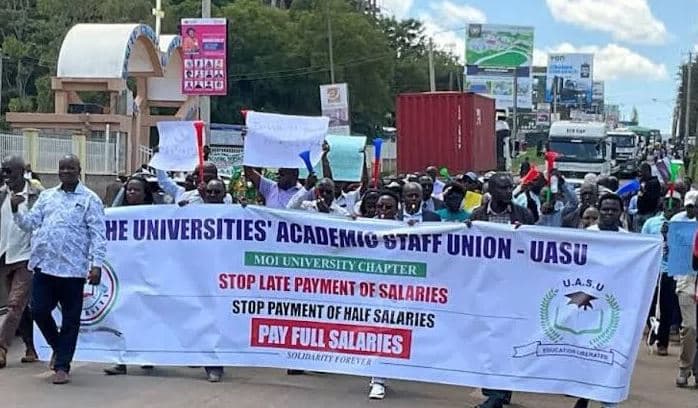We're loading the full news article for you. This includes the article content, images, author information, and related articles.
The future of thousands of Kenyan university students hangs in the balance as a nationwide lecturers' strike enters another week, deepening a crisis rooted in chronic underfunding and broken promises that threatens to cripple the higher education sector.

Public universities across Kenya remain shuttered as the government and the Universities Academic Staff Union (UASU) face a deadlock over a KSh7.76 billion debt. The strike, which began in mid-September 2025, has paralysed learning for tens of thousands of students and exposed the severe financial turmoil at the heart of Kenya's higher education system.
At the core of the dispute are arrears from the 2017–2021 Collective Bargaining Agreement (CBA). Following a joint verification exercise, the government acknowledged an outstanding amount of KSh7.76 billion. However, its proposal to pay the sum in three installments was swiftly rejected by UASU, which demands the full amount be paid in a single lump sum. "The government is proposing to implement the Sh7.9 billion in three phases—that's three strikes, and we don't want to subject our students to further frustration," stated UASU Secretary-General Constantine Wasonga. A subsequent offer to pay in two tranches was also rejected.
The government, through Education Cabinet Secretary Julius Ogamba, has urged lecturers to return to work, stating that most of their demands have been met and that negotiations for the 2025–2029 CBA are underway. On October 30, 2025, Treasury Cabinet Secretary John Mbadi approved a payout plan to settle the arrears over three financial years, with KSh2.16 billion to be released in the current 2025/26 fiscal year. However, the unions remain resolute, vowing to continue the strike until the full amount is reflected in their members' accounts.
The current strike is a symptom of a much deeper crisis: the systemic financial decay of Kenya's public universities. A damning report from Auditor-General Nancy Gathungu for the 2023/2024 financial year revealed that 21 public universities are at risk of financial collapse, having accumulated a negative working capital of KSh42.5 billion. By June 2024, total debt across public universities had surged to KSh76.1 billion, with many institutions unable to meet short-term obligations like remitting statutory deductions, including PAYE and pension contributions, amounting to KSh29.6 billion.
The Auditor-General's reports have consistently flagged widespread financial mismanagement, including unsupported expenditures and irregular allowances. This financial instability is so severe that institutions like Jomo Kenyatta University of Agriculture and Technology (JKUAT) have been forced to close indefinitely, ordering students to vacate the campus by Sunday, November 2, 2025. The crisis is further compounded by a struggling student funding model. The new Student-Centered Funding Model (SCFM) has faced criticism and legal challenges, with an Auditor General's report in July 2025 highlighting flaws such as inaccurate data submission and delays in fund disbursement.
The perpetual cycle of strikes has devastating consequences for students. The disruption extends academic calendars, with students who should graduate in four years often taking five or six. This delay not only imposes extra financial burdens on parents and guardians but also affects the mental well-being of students left idle and uncertain about their future. Many are forced to seek odd jobs to cover living expenses while they wait for classes to resume.
The quality of education is also severely compromised. When universities reopen, semesters are often compressed to make up for lost time, leading to rushed coursework and a shallow understanding of the material. One academic study on public universities in the Mount Kenya region found that such disruptions reduce lecture hours and that low-performing students are significantly less likely to graduate after a strike. This erosion of academic rigour raises concerns among employers about the quality and preparedness of graduates emerging from the public university system.
While up-to-date, direct salary comparisons with regional counterparts are not readily available, past data and union claims suggest that Kenyan academics may lag behind their peers in countries like Tanzania. A 2019 UASU proposal highlighted that a Kenyan lecturer was paid 50 percent less than their Tanzanian counterpart. The union's proposal for the 2025-2029 CBA seeks to significantly increase salaries, with the highest-paid professors earning over KSh1 million per month, arguing this is necessary to attract and retain qualified staff. The current impasse, rooted in the failure to honour past agreements, has created a deep sense of mistrust, making a swift resolution to the ongoing strike unlikely without significant concessions from the government.
Keep the conversation in one place—threads here stay linked to the story and in the forums.
Other hot threads
E-sports and Gaming Community in Kenya
Active 7 months ago
Popular Recreational Activities Across Counties
Active 7 months ago
The Role of Technology in Modern Agriculture (AgriTech)
Active 7 months ago
Investing in Youth Sports Development Programs
Active 7 months ago